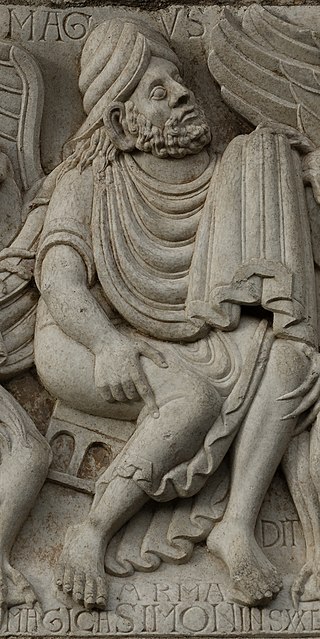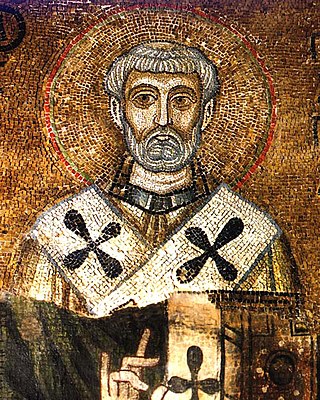Related Research Articles

Irenaeus was a Greek bishop noted for his role in guiding and expanding Christian communities in the southern regions of present-day France and, more widely, for the development of Christian theology by combating heterodox or Gnostic interpretations of Scripture as heresy and defining proto-orthodoxy. Originating from Smyrna, he had seen and heard the preaching of Polycarp, who in turn was said to have heard John the Evangelist, and thus was the last-known living connection with the Apostles.

Simon Magus, also known as Simon the Sorcerer or Simon the Magician, was a religious figure whose confrontation with Peter is recorded in Acts. The act of simony, or paying for position, is named after Simon, who tried to buy his way into the power of the Apostles.
In Christianity, Sabellianism is the Eastern Church equivalent to Patripassianism in the Western Church, which are both forms of theological modalism. Condemned as heresy, Modalism is the belief that the Father, Son and Holy Spirit are three different modes of God, as opposed to a Trinitarian view of three distinct persons within the Godhead. However, Von Mosheim, German Lutheran theologian who founded the pragmatic school of church historians, argues that Sabellius "believed the distinction of Father, Son, and Holy Spirit, described in the Scriptures, to be a real distinction, and not a mere appellative or nominal one."

Pope Clement I was bishop of Rome in the late first century AD. He is listed by Irenaeus and Tertullian as the bishop of Rome, holding office from 88 AD to his death in 99 AD. He is considered to be the first Apostolic Father of the Church, one of the three chief ones together with Polycarp and Ignatius of Antioch.

Hippolytus of Rome was one of the most important second-third century Christian theologians, whose provenance, identity and corpus remain elusive to scholars and historians. Suggested communities include Rome, Palestine, Egypt, Anatolia and other regions of the Middle East. The best historians of literature in the ancient church, including Eusebius of Caesarea and Jerome, openly confess they cannot name where Hippolytus the biblical commentator and theologian served in leadership. They had read his works but did not possess evidence of his community. Photios I of Constantinople describes him in his Bibliotheca as a disciple of Irenaeus, who was said to be a disciple of Polycarp, and from the context of this passage it is supposed that he suggested that Hippolytus so styled himself. This assertion is doubtful. One older theory asserts he came into conflict with the popes of his time and seems to have headed a schismatic group as a rival to the bishop of Rome, thus becoming an antipope. In this view, he opposed the Roman Popes who softened the penitential system to accommodate the large number of new pagan converts. However, he was reconciled to the Church before he died as a martyr.

James the Just, or a variation of James, brother of the Lord, was "a brother of Jesus", according to the New Testament. He was an early leader of the Jerusalem Church of the Apostolic Age. Traditionally, it is believed he was martyred in AD 62 or 69 by being stoned to death by the Pharisees on order of High Priest Ananus ben Ananus.

Simon the Zealot or Simon the Canaanite or Simon the Canaanean was one of the most obscure among the apostles of Jesus. A few pseudepigraphical writings were connected to him, but Jerome does not include him in De viris illustribus written between 392 and 393 AD.
Cerinthus was an early Gnostic, who was prominent as a heresiarch in the view of the early Church Fathers. Contrary to the Church Fathers, he used the Gospel of Cerinthus, and denied that the Supreme God made the physical world. In Cerinthus' interpretation, the Christ descended upon Jesus at baptism and guided him in ministry and the performing of miracles, but left him at the crucifixion. Similarly to the Ebionites, he maintained that Jesus was not born of a virgin, but was a mere man, the biological son of Mary and Joseph.

The Acts of Peter is one of the earliest of the apocryphal Acts of the Apostles in Christianity, dating to the late 2nd century AD. The majority of the text has survived only in the Latin translation of the Codex Vercellensis, under the title Actus Petri cum Simone. It is notable for a description of a miracle contest between Saint Peter and Simon Magus, the first record of the tradition that Saint Peter was crucified head-down, and as the origin of the saying Quo vadis?
The Basilidians or Basilideans were a Gnostic sect founded by Basilides of Alexandria in the 2nd century. Basilides claimed to have been taught his doctrines by Glaucus, a disciple of St. Peter, though others stated he was a disciple of the Simonian Menander.
The Discourse to the Greeks concerning Hades, also called Against Plato on the Cause of the Universe, is a short treatise believed to be the work of Hippolytus of Rome. It was erroneously attributed to the Jewish historian Josephus since at least the 9th century and was first published in a translation of Josephus' works by William Whiston. As Whiston's translation is in the public domain, it appears in many present-day English editions of Josephus' work without any noting of its erroneous attribution.
The Simonians were a Gnostic sect of the 2nd century which regarded Simon Magus as its founder and traced its doctrines, known as Simonianism, back to him. The sect flourished in Syria, in various districts of Asia Minor and at Rome. In the 3rd century remnants of it still existed, which survived until the 4th century.

Subordinationism is a Trinitarian doctrine wherein the Son is subordinate to the Father. Not only in submission and role, but with actual ontological subordination to varying degrees. It posits a hierarchical ranking of the persons of the Trinity, implying ontological subordination of the persons of the Son and the Holy Spirit. It was condemned as heretical in the Second Council of Constantinople.

Against Heresies, sometimes referred to by its Latin title Adversus Haereses, is a work of Christian theology written in Greek about the year 180 by Irenaeus, the bishop of Lugdunum.
The Refutation of All Heresies, also called the Elenchus or Philosophumena, is a compendious Christian polemical work of the early third century, whose attribution to Hippolytus of Rome or an unknown "Pseudo-Hippolytus" is disputed. It catalogues both pagan beliefs and 33 gnostic Christian systems deemed heretical by Hippolytus, making it a major source of information on contemporary opponents of Christian orthodoxy as understood today.
Caius, Presbyter of Rome was a Christian author who lived and wrote towards the beginning of the 3rd century. Only fragments of his works are known, which are given in the collection entitled The Ante-Nicene Fathers. However, the Muratorian fragment, an early attempt to establish the canon of the New Testament, is often attributed to Caius and is included in that collection.

Debate exists as to whether the earliest Church Fathers in Christian history believed in the doctrine of the Trinity – the Christian doctrine that God the Father, God the Son and God the Holy Spirit are three distinct persons sharing one homoousion (essence).

In Christian eschatology, the Antichrist refers to people prophesied by the Bible to oppose Jesus Christ and substitute themselves in Christ's place before the Second Coming. The term Antichrist is found four times in the New Testament, solely in the First and Second Epistle of John. The Antichrist is announced as the one "who denies the Father and the Son."

Christianity in the ante-Nicene period was the time in Christian history up to the First Council of Nicaea. This article covers the period following the Apostolic Age of the first century, c. 100 AD, to Nicaea in 325 AD.
References
- ↑ Koskenniemi, Erkki. The Old Testament Miracle-workers in Early Judaism. p. 9.
- ↑ Sir James Donaldson. Ante-Nicene Christian Library: Hippolytus, Bishop of Rome, v. 1 (1868). Princeton University. p. 197.
- ↑ G. R. S. Mead. Simon Magus: His Philosophy and Teachings. Book Tree. p. 12.
Ferreiro, Alberto. Simon Magus in Patristic, Medieval And Early Modern Traditions. BRILL. p. 42. - ↑ John Murray. THE QUARTERLY REVIEW. VOL. LXXXIX. JUNE & SEPTEMBER 1851. Oxford University. p. 151.
Arthur Cleveland Coxe (1995). Ante-Nicene Fathers: Hippolytus. Cyprian. Caius. Novatian. Appendix. Hendrickson Publishers. p. 74. - ↑ David Stone Potter. Life, Death, and Entertainment in the Roman Empire. University of Michigan Press. p. 115.
Hippolytus. The Refutation of All Heresies (Complete). Library of Alexandria. p. 260. ISBN 9781465527981.